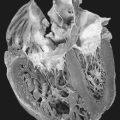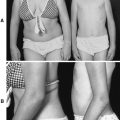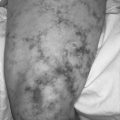73. Pulmonary Hemosiderosis
Definition
Pulmonary hemosiderosis is repeated or chronic episodes of intra-alveolar bleeding resulting in iron accumulation (hemosiderin) in alveolar macrophages, culminating in pulmonary fibrosis and severe anemia. It can occur as either a primary or secondary disease process.
Incidence
The rate of occurrence of pulmonary hemosiderosis is low but the disease is well recognized. Exact figures of the incidence of pulmonary hemosiderosis have not been reported. In patients younger than 10 years of age, there is a 1:1 male to female ratio, but after 10 years of age, it increases to a 2:1 male to female ratio.
Etiology
Primary pulmonary hemosiderosis has three established variants:
1. Associated with antiglomerular basement membrane (Goodpasture syndrome, see p. 152)
2. Associated with hypersensitivity to cow’s milk proteins (Heiner syndrome)
3. Idiopathic pulmonary hemosiderosis
The patient with idiopathic pulmonary hemosiderosis has a poor prognosis; the mean survival after diagnosis is generally 2.5 to 5 years. Secondary pulmonary hemosiderosis may develop as the result of a number of systemic disorders.
Causes of Secondary Hemosiderosis
Congenital/Acquired Cardiopulmonary Anomalies
• Bronchogenic cyst
• Congenital arteriovenous fistula
• Congenital pulmonary vein stenosis
• Eisenmenger syndrome (see p. 110)
• Left ventricular failure
• Mitral valve stenosis
• Pulmonary arterial stenosis
• Pulmonary embolism
• Pulmonary sequestration
• Pulmonic valve stenosis
• Tetralogy of Fallot
Drugs
• Cocaine
• Penicillamine
Environmental Molds
• Congenital hyperammonemia
• Memroniella echinata
Immunologic Disorders
Infections
• Bacterial pneumonia
• Bronchiectasis
• Disseminated intravascular coagulation (DIC)
• Pulmonary abscess
• Sepsis
Neoplasms
• Metastatic lesions (sarcoma, Wilms’ tumor, osteogenic sarcoma)
• Primary bronchial tumors (adenoma, carcinoid, sarcoma, hemangioma, angioma)
Miscellaneous Causes
• Congenital hyperammonemia
• Pulmonary alveolar proteinosis
• Pulmonary trauma
• Retained foreign body
Signs and Symptoms
• Chronic fatigue
• Chronic rhinitis
• Clubbing of digits
• Cough
• Crackles
• Cyanosis
• Diffuse pulmonary infiltrates
• Dyspnea
• Fever
• Frank respiratory failure
• Growth failure
• Hemoptysis
• Hypoxia
• Iron deficient anemia
• Pallor
• Poor weight gain
• Recurrent cough
• Recurrent otitis media
• Severe exercise limitation
• Tachypnea
• Wheezing
Medical Management
For medical management interventions associated with Goodpasture syndrome, see p. 152.
In general, pulmonary hemosiderosis is treated with oxygen supplementation and blood transfusion in cases of severe anemia and/or shock. Severe pulmonary manifestations may include excessive secretions and bronchospasm.
Intubation and mechanical ventilation may be necessary for the patient with severe pulmonary hemorrhage.
Heiner syndrome is best treated by completely eliminating cow’s milk from the patient’s diet, along with other dairy products.
The patient with secondary pulmonary hemosiderosis may receive the same general treatment measures described above. Additionally, the treatment regimen focuses primarily on the systemic disorder/disease from which the pulmonary hemosiderosis has emerged.
There are no specific surgical interventions indicated in the treatment of pulmonary hemosiderosis.
Complications
• Cor pulmonale
• Pulmonary fibrosis
• Pulmonary hemorrhage
• Pulmonary hypertension
• Respiratory failure
Anesthesia Implications
As the name of the disorder implies, the primary organs affected are the lungs. Serial chest x-rays may demonstrate transient perihilar and basilar infiltrates that produce a mottled appearance.
The patient should be evaluated preoperatively for iron deficiency anemia. Preoperative transfusion(s) should be based on the patient’s compensatory abilities and anticipated blood loss during the perioperative period.
The pulmonary effects combined with the anemia conspire to reduce the oxygen-carrying capacity as well as gas exchange in general. Prudence dictates obtaining an arterial blood gas sample preoperatively to assess the pulmonary effects of the disease.
Because of the need to deliver good pulmonary toilet, the anesthetist should insert a larger than usual endotracheal tube.
Pulmonary fibrosis, to the degree present, produces a pattern of restrictive lung disease. Prolonging the inspiratory phase, minimizing the inspiratory pressure, and lengthening the expiratory phase will reduce the possibility of barotraumas. These parameters may be accomplished in one of two ways:
1. Possibly the simpler option would be to select pressure-controlled ventilation with a lower peak inspiratory pressure setting; this option is available on many newer models of anesthesia machines.
2. If the anesthetist does not have access to a newer model anesthesia machine, manual ventilation using the reservoir bag is an option, but because of the possibility of anesthetist fatigue, it is probably best to use this method only when the proposed procedure is estimated to require 1 hour or less.
In addition to inspiratory pressure reduction, the inspiratory:expiratory (I:E) ratio should be prolonged, possibly to 1:2.5, 1:3, or 1:3.5, to allow for completion of expiration and reduce air trapping and possible barotrauma as well. Postoperative ventilatory support should be anticipated, particularly in cases of pulmonary hemorrhage. Depending on the degree of pulmonary hemorrhage, the anesthetist may need to consider additional invasive monitoring, such as direct arterial pressure and central venous pressure, to guide fluid resuscitation and/or transfusion therapy.







